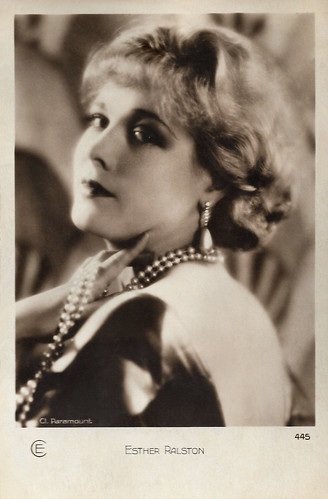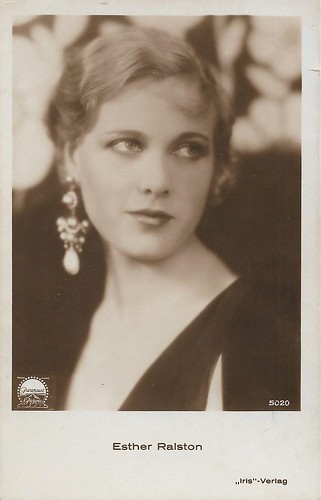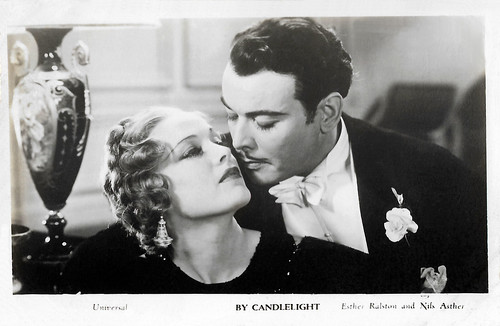Projected as wholesome but fun-loving, Maine-born leading lady Esther Ralston (1902-1994) enjoyed a prime silent age career. She appeared in close to 100 films over a nearly 30-year period. At her peak, she was packaged and publicised as 'The American Venus' by Florenz Ziegfeld Jr. after appearing as a dazzling beauty queen in the film The American Venus (1926). A decade later, the blonde beauty's career, however, had tapered off.

Dutch postcard. Photo: Universal.

German postcard by Ross Verlag, no. 4329/1, 1929-1930. Photo: Paramount. Esther Ralston in The Case of Lena Smith (Josef von Sternberg, 1929).

German postcard by Ross Verlag, no. 4329/2, 1929-1930. Photo: Paramount. Esther Ralston in The Wheel of Life (Victor Schertzinger, 1929). Collection: Geoffrey Donaldson Institute.

German postcard by Ross Verlag, no. 4800/1, 1929-1930. Photo: Paramount-Film.

British postcard in the Colourgraph Series, London, no. C. 25.
Esther Ralston was christened Esther Louise Worth in Bar Harbor, Maine, USA, in 1902. Her parents graced the burlesque, carnival and vaudeville circuits.
By the time she was 2, she had become a part of the family act which included four brothers. The billing was extended to 'The Ralston Family with Baby Esther, America's Youngest Juliet.'
As a teen, Esther broke into silent films. Her first appearance was as an angel in The Deep Purple (James Young, 1915), starring Clara Kimball Young and Milton Sills, and filmed at the World Studios in New Jersey.
Afterward, the 13 years old actress appeared with her family in live theatre productions at smaller venues, eventually crossing the continent and finding themselves in Los Angeles. As early as 1918 she and her brothers began finding extra work at Universal City.
After several unbilled roles, she went on to become one of filmdom's highest-paid silent stars. Her lesser-known younger brother Howard Ralston also worked as an actor on the silent screen. They both had roles in the Mark Twain classic Huckleberry Finn (William Desmond Taylor, 1920).
Esther appeared in scores of dramas, comedies, and Westerns. Her more familiar earlier roles were as Mrs. Darling in the silent classic Peter Pan (Herbert Brenon, 1924), as the Fairy Godmother in A Kiss for Cinderella (Herbert Brenon, 1925), and as the lead in American Venus (Frank Tuttle, 1926). She appeared mainly in comedies, often portraying spirited society girls, but she also received good reviews for her forays into dramatic roles.

German postcard by Ross Verlag, no. 1433/1, 1927-1928. Photo: Paramount-Film.

German postcard by Ross Verlag, no. 3519/2, 1928-1929. Photo: Paramount.

German postcard by Ross Verlag, Berlin, no. 3813/1, 1928-1929. Photo: Paramount.

German postcard by Ross Verlag, no. 4984/1, 1929-1930. Photo: Paramount.

German postcard by Ross Verlag, no. 5144/1, 1930-1931. Photo: Paramount.
Around the advent of sound, Esther Ralston made several films for Paramount and MGM, including her first talkie The Sawdust Paradise (Luther Reed, 1928). She played the title role in The Case of Lena Smith (1929) directed by Josef von Sternberg. The Case of Lena Smith is ranked by film critics as among the 'lost masterpieces' of the silent era and the Holy Grail for archivists who sift through film repositories.
Ralston also starred in Betrayal (Lewis Milestone, 1929), with Emil Jannings and Gary Cooper, and in the romantic musical The Prodigal (Harry A. Pollard, 1931) opposite Metropolitan opera star Lawrence Tibbett. The Prodigal was extremely provocative in its time in that it viewed adultery in a non-judgmental, even positive light.
At one point Ralston earned $8000 a week, and garnered much popularity, especially in Britain. In England, she appeared opposite Basil Rathbone in the comedy After the Ball (Milton Rosmer, 1932), and opposite Conrad Veidt in the thriller Rome Express (Walter Forde, 1932). The latter won the American National Board of Review award for Best Foreign Film.
She returned to Hollywood the following year and was put under contract to MGM. A little gem is the sparkling comedy By Candlelight (James Whale, 1933) with Elissa Landi, Paul Lukas, and Nils Asther. The sophisticated romantic comedy is chock full of delightfully double-entendre pre-Code dialogue and classy directorial touches.
Her last leading role was in To the Last Man (1933), directed by Henry Hathaway and starring Randolph Scott. According to IMDb, she was loaned out for B films, because she rejected Louis B. Mayer's advances. Her film career declined.
After supporting roles in Tin Pan Alley (Walter Lang, 1940) starring Alice Faye and Betty Grable, and San Francisco Docks (Arthur Lubin, 1940), Ralston retired from the big screen. Earlier, she had lost her film fortune due to the stock market crash. She appeared on stage and in radio soaps and was occasionally glimpsed on TV in the 1950s and early 1960s.
Forced to find jobs outside of the world of entertainment, she worked in department stores, a talent agency, and a utility company to support herself. In 1985, Ralston released her autobiography, 'Some Day We'll Laugh'.
At the age of 91, Esther Ralston died of a heart attack in her home in Ventura, California, in 1994. She was married thrice. Her first two husbands were actor/director George Webb (1925-1933) and actor/singer Will Morgan (1934-1938). With radio announcer and columnist Ted Lloyd, she was married from 1939 till 1954. Esther Ralston had two daughters and one son from her marriages.

French postcard by Cinémagazine-Edition, Paris, no. 445. Photo: Paramount.

Austrian postcard by Iris Verlag, no. 5020. Photo: Paramount.

British postcard in the Film Shots series by Film Weekly. Photo: Universal. Nils Asther and Esther Ralston in By Candlelight (James Whale, 1933).

British postcard in the Film Shots series by Film Weekly. Photo: Universal. Nils Asther, Paul Lukas, and Esther Ralston in By Candlelight (James Whale, 1933).

Small, British collectors card in the Film Stars series by Player's Cigarettes, no. 37. Illustration: MGM.
Sources: Gary Brumburgh (IMDb), Wikipedia, and IMDb.

Dutch postcard. Photo: Universal.

German postcard by Ross Verlag, no. 4329/1, 1929-1930. Photo: Paramount. Esther Ralston in The Case of Lena Smith (Josef von Sternberg, 1929).

German postcard by Ross Verlag, no. 4329/2, 1929-1930. Photo: Paramount. Esther Ralston in The Wheel of Life (Victor Schertzinger, 1929). Collection: Geoffrey Donaldson Institute.

German postcard by Ross Verlag, no. 4800/1, 1929-1930. Photo: Paramount-Film.

British postcard in the Colourgraph Series, London, no. C. 25.
One of filmdom's highest-paid silent stars
Esther Ralston was christened Esther Louise Worth in Bar Harbor, Maine, USA, in 1902. Her parents graced the burlesque, carnival and vaudeville circuits.
By the time she was 2, she had become a part of the family act which included four brothers. The billing was extended to 'The Ralston Family with Baby Esther, America's Youngest Juliet.'
As a teen, Esther broke into silent films. Her first appearance was as an angel in The Deep Purple (James Young, 1915), starring Clara Kimball Young and Milton Sills, and filmed at the World Studios in New Jersey.
Afterward, the 13 years old actress appeared with her family in live theatre productions at smaller venues, eventually crossing the continent and finding themselves in Los Angeles. As early as 1918 she and her brothers began finding extra work at Universal City.
After several unbilled roles, she went on to become one of filmdom's highest-paid silent stars. Her lesser-known younger brother Howard Ralston also worked as an actor on the silent screen. They both had roles in the Mark Twain classic Huckleberry Finn (William Desmond Taylor, 1920).
Esther appeared in scores of dramas, comedies, and Westerns. Her more familiar earlier roles were as Mrs. Darling in the silent classic Peter Pan (Herbert Brenon, 1924), as the Fairy Godmother in A Kiss for Cinderella (Herbert Brenon, 1925), and as the lead in American Venus (Frank Tuttle, 1926). She appeared mainly in comedies, often portraying spirited society girls, but she also received good reviews for her forays into dramatic roles.

German postcard by Ross Verlag, no. 1433/1, 1927-1928. Photo: Paramount-Film.

German postcard by Ross Verlag, no. 3519/2, 1928-1929. Photo: Paramount.

German postcard by Ross Verlag, Berlin, no. 3813/1, 1928-1929. Photo: Paramount.

German postcard by Ross Verlag, no. 4984/1, 1929-1930. Photo: Paramount.

German postcard by Ross Verlag, no. 5144/1, 1930-1931. Photo: Paramount.
The Holy Grail for film archivists
Around the advent of sound, Esther Ralston made several films for Paramount and MGM, including her first talkie The Sawdust Paradise (Luther Reed, 1928). She played the title role in The Case of Lena Smith (1929) directed by Josef von Sternberg. The Case of Lena Smith is ranked by film critics as among the 'lost masterpieces' of the silent era and the Holy Grail for archivists who sift through film repositories.
Ralston also starred in Betrayal (Lewis Milestone, 1929), with Emil Jannings and Gary Cooper, and in the romantic musical The Prodigal (Harry A. Pollard, 1931) opposite Metropolitan opera star Lawrence Tibbett. The Prodigal was extremely provocative in its time in that it viewed adultery in a non-judgmental, even positive light.
At one point Ralston earned $8000 a week, and garnered much popularity, especially in Britain. In England, she appeared opposite Basil Rathbone in the comedy After the Ball (Milton Rosmer, 1932), and opposite Conrad Veidt in the thriller Rome Express (Walter Forde, 1932). The latter won the American National Board of Review award for Best Foreign Film.
She returned to Hollywood the following year and was put under contract to MGM. A little gem is the sparkling comedy By Candlelight (James Whale, 1933) with Elissa Landi, Paul Lukas, and Nils Asther. The sophisticated romantic comedy is chock full of delightfully double-entendre pre-Code dialogue and classy directorial touches.
Her last leading role was in To the Last Man (1933), directed by Henry Hathaway and starring Randolph Scott. According to IMDb, she was loaned out for B films, because she rejected Louis B. Mayer's advances. Her film career declined.
After supporting roles in Tin Pan Alley (Walter Lang, 1940) starring Alice Faye and Betty Grable, and San Francisco Docks (Arthur Lubin, 1940), Ralston retired from the big screen. Earlier, she had lost her film fortune due to the stock market crash. She appeared on stage and in radio soaps and was occasionally glimpsed on TV in the 1950s and early 1960s.
Forced to find jobs outside of the world of entertainment, she worked in department stores, a talent agency, and a utility company to support herself. In 1985, Ralston released her autobiography, 'Some Day We'll Laugh'.
At the age of 91, Esther Ralston died of a heart attack in her home in Ventura, California, in 1994. She was married thrice. Her first two husbands were actor/director George Webb (1925-1933) and actor/singer Will Morgan (1934-1938). With radio announcer and columnist Ted Lloyd, she was married from 1939 till 1954. Esther Ralston had two daughters and one son from her marriages.

French postcard by Cinémagazine-Edition, Paris, no. 445. Photo: Paramount.

Austrian postcard by Iris Verlag, no. 5020. Photo: Paramount.

British postcard in the Film Shots series by Film Weekly. Photo: Universal. Nils Asther and Esther Ralston in By Candlelight (James Whale, 1933).

British postcard in the Film Shots series by Film Weekly. Photo: Universal. Nils Asther, Paul Lukas, and Esther Ralston in By Candlelight (James Whale, 1933).

Small, British collectors card in the Film Stars series by Player's Cigarettes, no. 37. Illustration: MGM.
Sources: Gary Brumburgh (IMDb), Wikipedia, and IMDb.
No comments:
Post a Comment